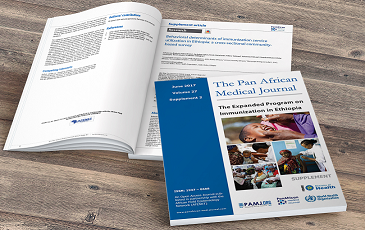Nonfunctional double parathyroid carcinoma with incidental thyroid micropapillary carcinoma: a rare case
Kursat Dikmen, Hasan Bostanci, Huseyin Gobut, Alp Yildiz, Onur Ertunc, Ali Celik, Murat Akin, Ferit Taneri
Corresponding author: Kursat Dikmen, Department of General Surgery, Gazi University Medical Faculty, Ankara, Turkey 
Received: 25 Dec 2016 - Accepted: 12 Jul 2017 - Published: 02 Aug 2017
Domain: Clinical medicine
Keywords: Non-functional parathyroid carcinoma, double parathyroid carcinoma, thyroid papillary carcinoma
©Kursat Dikmen et al. Pan African Medical Journal (ISSN: 1937-8688). This is an Open Access article distributed under the terms of the Creative Commons Attribution International 4.0 License (https://creativecommons.org/licenses/by/4.0/), which permits unrestricted use, distribution, and reproduction in any medium, provided the original work is properly cited.
Cite this article: Kursat Dikmen et al. Nonfunctional double parathyroid carcinoma with incidental thyroid micropapillary carcinoma: a rare case. Pan African Medical Journal. 2017;27:241. [doi: 10.11604/pamj.2017.27.241.11503]
Available online at: https://www.panafrican-med-journal.com/content/article/27/241/full
Original article 
Nonfunctional double parathyroid carcinoma with incidental thyroid micropapillary carcinoma: a rare case
Nonfunctional double parathyroid carcinoma with incidental thyroid micropapillary carcinoma: a rare case
Kursat Dikmen1,&, Hasan Bostanci1, Huseyin Gobut1, Alp Yildiz1, Onur Ertunc2, Ali Celik3, Murat Akin1, Ferit Taneri1
1Department of General Surgery, Gazi University Medical Faculty, Ankara, Turkey, 2Department of Pathology, Gazi University Medical Faculty, Ankara, Turkey, 3Department of Thoracic Surgery, Gazi University Medical Faculty, Ankara, Turkey
&Corresponding author
Kursat Dikmen, Department of General Surgery, Gazi University Medical Faculty, Ankara, Turkey
Parathyroid carcinomas are rare endocrine tumors which comprise 0.3-5.6% of all causes of hyperparathyroidism. 90% of them are hormonally active, while 10% of them may be non-functional. They mostly occur in a single parathyroid gland. Concurrent involvement of both parathyroid glands is quite rare. A 57-year-old male patient was admitted to emergency department with the complaint of dyspnea. Thorax tomography revealed a retrosternal mass. The mass was thoracoscopically excised by thoracic surgeons. Histopathological examination result of the mass was reported as parathyroid carcinoma. Parathyroid scintigraphy performed and focal activity increase in the lower pole of the left lobe. Parathyroid hormone level was 118 pg/ml and calcium level was measured as 11.4 mg/dl. The patient with these findings was operated and pathological examination of excised left lower parathyroid tissue was reported as carcinoma. In addition, micropapillary carcinoma was detected in left thyroid lobectomy specimen.Our case was also unusual in that double parathyroid carcinoma, which is a rare condition, was hormonally inactive. We aimed to present our case in the light of the literature due to its rare occurrence.
The most common causes of primary hyperparathyroidism are adenoma and hyperplasia, while carcinoma is rarely seen with a prevalence of 0.3-5.6% [1, 2]. Parathyroid carcinomas are generally hormonally active, about 10% of them are non-functional [3, 4]. In hormonally active patients, increased levels of parathyroid hormone (PTH) (8-10 times the normal value), calcium (>14 mg/dl) and alkaline phosphatase are specific. However, there is a group of patients with hormonally inactive disease in which calcium and PTH levels are normal or minimally increased [5-7]. Only 1 case has been reported in the literature, which concurrently had this rare endocrine malignancy, and histologically proven double carcinoma [8]. Furthermore, co-occurrence of parathyroid and thyroid pathologies is also a rare condition and it is mostly detected incidentally after surgery [9-11]. There is no study in the literature reporting co-occurrence of non-functioning parathyroid carcinoma involving both sides and thyroid micropapillary carcinoma. For this reason, we aimed to present our case in the light of the literature.
57-year old male patient was admitted to emergency department with dyspnea and tachypnea. Thorax computed tomography (CT) examination was performed with the initial diagnosis of pulmonary embolism, which revealeda 3x2 cm sized mass located lateral to sternum in the left side of anterior mediastinum (Figure 1). The mediastinal mass was thoracoscopically removed by en bloc excision. Since histopathological examination revealed parathyroid carcinoma, general surgery consultation was made.
On physical examination, there was no palpable mass in both thyroid lobes and no cervical lymph nodes. Review of organ systems revealed nothing pathological. He had no history of previous surgical operation and regular drug treatment. Laboratory parameters were as follows; Calcium: 11.4 mg/dl, phosphorus: 1.79 mg/dl, parathyroid hormone: 118.7 pg/ml, calcitonin: < 2 pg/ml and 25 hydroxy vitamin D: 21.84 ug/l. Neck ultrasonography (USG) detected a 25x11 mm sized lesion which was adjacent to left thyroid lobe inferoposteriorly, extending caudally and had cystic areas. This lesion had moderate level vascularity on Doppler Ultrasonography. The remaining of thyroid tissue was normal and no pathological lymph node was detected. Neck and thorax diffusion MR examinations demonstrated a 21x11 mm sized cystic lesion in parathyroid region, which was located posterior to lower part of left thyroid lobe and had clear margins. There was no suspicious appearance in the region of previous operation. Technetium-99m methoxy-isobutylisonitrile(Tc-99m MIBI) parathyroid scintigraphic examination was performed which showed early and late phase focal activity increase adjacent to lower pole of left lobe. On whole body bone densitometry, AP spine bone mineral density values (T score) and age matched (Z score) value revealed osteopenia, while right proximal femoral neck bone mineral density values (T score) showed osteopenia and age matched value (Z score) was normal. Laboratory parameters on the day before the operation were as follows; Calcium: 11.1 mg/dl, phosphorus: 2.39 mg/dl, PTH: 184 pg/ml, thyroid function tests and thyroglobulin levels: normal.
Left inferior parathyroid gland peroperatively appeared bigger than normal and connected to superior parathyroid gland by a band (Figure 2). Both parathyroid tissues were excised and it was confirmed by frozen that the excised tissues were parathyroid glands. Intact PTH values measured 15 and 30 minutes after parathyroid excision were 78 and 52 pg/ml, respectively. Since intact PTH (iPTH) levels decreased by 70% of pre-operative values and the appearance of other parathyroid glands were not pathological, the operation was terminated after left thyroid lobectomy, isthmectomy+unilateral central lymph node dissection were performed (Figure 3). Serum calcium and PTH values measured 24 hours after the operation were 9.2 mg/dl and 63 pg/ml, respectively.
Histopathological evaluation
90% of the tumors had fibrous bands and trabecular structures seen in microscopic examination. 67% of them had capsular invasion, 12% showed vascular invasion, while mitosis and fusiform tumoral cells were present in 81% (Figure 2 and Figure 4). Extra-parathyroidal lesion was immunohistochemically excluded by means of PTH, TTF-1, PAX-8, HMB45, Melan-A, CD117, desmin and vimentin. We detected a strong staining by Galectin-3 and Cyclin-D1, which were used to differentiate parathyroid adenoma and carcinoma. 2% increase in proliferation was observed by Ki-67 (Figure 5).
The most common causes of primary hyperparathyroidism are adenoma and hyperplasia, while carcinoma is rarely seen with a prevalence of 0.3-5.6% [1, 2]. Parathyroid carcinoma is typically seen between the ages of 45 and 60 years with equal frequencies in both genders [7].
Although its etiopathology is not clear, increase in HRPT-2 tumor suppressor gene has been thought to play role in the etiology [12]. In addition, hyperparathyroidism may be seen sporadically or as a part of a genetic syndrome such as hyperparathyroidism jaw-tumor syndrome (HPT-JT), multiple endocrine neoplasia type-1 (MEN-1), MEN-2A and isolated familial hyperparathyroidism [7]. Although there are no established risk factors other than these genetic syndromes, it is more common in the patients with parathyroid gland hyperplasia related to chronic renal failure and radiation exposure to neck region [7]. In our case, parathyroid carcinoma was not a part of a genetic syndrome and the patient had none of the known risk factors for carcinoma.
Most of the parathyroid carcinomas are hormonally active, while 10% of them are non-functional [3, 4]. Increased levels of parathyroid hormone (8-10 times the normal value), calcium (>14 mg/dl) and alkaline phosphatase are usually detected in the patients with functional disease [5-7]. Clinical picture may include polyuria, renal colic, nephrolithiasis, bone pain, osteopenia, pathologic fractures, nausea, abdominal pain, peptic ulcer, pancreatitis, fatigue and depression [6, 7, 13]. In the patients with non-functional disease, hoarseness secondary to recurrent laryngeal nerve invasion, palpable neck mass, symptoms and signs of distant metastasis may be present in the absence of these symptoms [3, 4]. Since our case did not have classical clinical and laboratory findings of parathyroid carcinoma, he was accepted to have non-functional disease.
There is no specific imaging method that is used alone for parathyroid diseases. Technetium-99m Sestamibi scan and neck USG examinations are generally used [14]. In addition, imaging modalities such as neck magnetic resonance (MR) and CT are commonly used methods in detecting regional lymph nodes, invasion to surrounding tissues or distant organ metastasis [14]. In a study, sensitivities of sestamibi scan, MR, CT and USG examinations were reported to be 79%, 93%, 69% and 83%, respectively [14]. In our case, 20 mCiTc-99m MIBI parathyroid scintigraphic examination revealed focal activity increase in the lower pole of left thyroid lobe. A 20x10 mm sized lesion which was located in parathyroid region and had moderate level of vascularity was detected on neck and thyroid USG. MR examination performed for staging demonstrated a 21x11 mm sized cystic mass which was located in the left parathyroid region and showed weak peripheral contrast enhancement. Although the lesion was in a close relationship with cervical part of the esophagus, any evidence of infiltration was not observed.
Surgical treatment is the only curative modality for long term survival. In addition to the excision of pathological gland, ipsilateral thyroidectomy is also recommended [12, 13].In parathyroid carcinomas, the rates of invasion were 89% for ipsilateral thyroid gland, 71% for strap muscles, 26% for ipsilateral recurrent laryngeal nerve, 17% for esophagus and 17% for trachea [15]. Cervical lymph node involvement may be seen in about 15-30% of the cases [14, 15]. In case of pre-operative or intra-operative detection of lymph nodes, ipsilateral lymph node dissection is recommended after verification of metastasis in these lymph nodes. Prophylactic lateral neck dissection is controversial. In our case, we also performed left thyroid lobectomy and excision of left upper and lower parathyroid glands which were thought to be pathological. Parathyroid carcinoma had no invasion to thyroid lobe but micropapillary carcinoma 2 mm in diameter was detected in the excised thyroidectomy material.
In a study on the prognosis of the disease, 5 and 10-year survival rates were reported as 85.5% and 49.1%, respectively [16]. A study involving 224 patients reported a 10-year survival rate of 67.8% [1]. Although it is a rare cancer, many studies reported the most important prognostic factor as the success of en bloc resection performed in the initial surgical operation [14]. In the study by Koea and Shaw, in addition to R0 resection they performed, metastasis to lymph nodes and distant organs and non-functional status at the time of diagnosis were reported as poor prognostic factors [17]. Besides these factors, Harari et al. suggested that the number of recurrences and high calcium levels during recurrence were poor prognostic factors [17]. However, there are also studies suggesting that lymph node involvement was not a poor prognostic factor. Because regional lymph node metastasis are not common. But ipsilateral lymph node dissection must be performed if any lymph nodes are detected [18, 19].
In our case with bifocal parathyroid carcinoma as a rare pathology, it should be considered that one of these focuses might have been originated from ectopic parathyroid tissue. Furthermore, our case was unique in that the disease was non-functional and the patient had concurrent micropapillary carcinoma detected on ipsilateral thyroidectomy specimen, which have not been reported before in the literature. It should be remembered that all of these variables may be present in the same patient, diagnosis and treatment algorithm should be arranged considering this situation.
The authors declare no competing interest.
All authors participated in the preparation of the manuscript. KD collected the case information and drafted the manuscript. All authors read and approved the final manuscript.
Figure 1: preoperative tomography image of the mass lateral to sternum at the left
Figure 2: A) 25x10 magnification
H&E and parathyroid pathology section; stained border surrounding connective
tissue and partly capsule (arrow); B) 4x10 magnification H&E tumoral area in
surrounding connective tissue (asterisk)
Figure 3: intraoperative macroscopic appearance of left upper and lower parathyroid glands
Figure 4: A) 40x10 magnification
H&E, note clear cytoplasm, marked cell membrane, eccentric cell nucleus, patchy
nuclear hypertrophy (arrow); cells are arranged as trabeculae and in clusters;
B) 4x10 magnification H&E, arrows show peripheral thick capsule which was invaded
by tumoral focuses that pass over the capsule to infiltrate surrounding connective
tissue. Black capsule marked with asterisk is external surface surgical margin
Figure 5: A) 10x10 streptavidin
peroxidase staining, PTH immunohistochemical staining, diffuse strong cytoplasmic
and membranous staining; B) 20x10 streptavidin peroxidase staining, cyclin
D1 immunohistochemical staining, diffuse strong nuclear staining; C) 20x10
streptavidin peroxidase staining, Galectin-3 immunohistochemical staining, patchy
strong cytoplasmic and nuclear staining; D) 20x10 streptavidin peroxidase staining,
ki-67 immunohistochemical staining, note 2% nuclear staining
- Lee PK, Jarosek SL, Virnig BA, Evasovich M, Tuttle TM. Trends in the incidence and treatment of parathyroid cancer in the United States. Cancer. 2007 May 01; 109(9): 1736-41. PubMed | Google Scholar
- Wynne AG, van Heerden J, Carney JA, Fitzpatrick LA. Parathyroid carcinoma: clinical and pathologic features in 43 patients. Medicine. 1992 Jul; 71(4): 197-205. PubMed | Google Scholar
- Gao WC, Ruan CP, Zhang JC, Liu HM, Xu XY, Sun YP et al. Nonfunctional parathyroid carcinoma. Journal of cancer research and clinical oncology. 2010 Jul; 136(7): 969-74. PubMed | Google Scholar
- Wilkins BJ, Lewis JS, Jr. Non-functional parathyroid carcinoma: a review of the literature and report of a case requiring extensive surgery. Head and Neck Pathology. 2009 Jun; 3(2): 140-9. PubMed | Google Scholar
- Dudney WC, Bodenner D, Stack BC, Jr. Parathyroid carcinoma. Otolaryngologic clinics of North America. 2010 Apr; 43(2): 441-53, xi. PubMed | Google Scholar
- Kebebew E. Parathyroid carcinoma. Curr Treat Options Oncol. 2001 Aug; 2(4): 347-54. PubMed | Google Scholar
- Shane E. Clinical review 122: Parathyroid carcinoma. J Clin Endocrinol Metab. 2001 Feb; 86(2): 485-93. PubMed | Google Scholar
- Kameyama K, Takami H. Double parathyroid carcinoma. Endocrine journal. 2003 Aug;50(4):477-9. PubMed | Google Scholar
- Calcaterra TC, Paglia D. The coexistence of parathyroid adenoma and thyroid carcinoma. The Laryngoscope. 1979 Jul; 89(7 Pt 1): 1166-9. PubMed | Google Scholar
- Krause U, Olbricht T, Metz K, Rudy T, Benker G. Coincidence of non-medullary thyroid cancer and hyperparathyroidism. Der Chirurg; Zeitschrift fur alle Gebiete der operativen Medizen. 1991 Jul; 62(7): 536-9. PubMed | Google Scholar
- Morita SY, Somervell H, Umbricht CB, Dackiw AP, Zeiger MA. Evaluation for concomitant thyroid nodules and primary hyperparathyroidism in patients undergoing parathyroidectomy or thyroidectomy. Surgery. 2008 Dec; 144(6): 862-6; discussion 6-8. PubMed | Google Scholar
- Rawat N, Khetan N, Williams DW, Baxter JN. Parathyroid carcinoma. The British journal of surgery. 2005 Nov; 92(11): 1345-53. PubMed | Google Scholar
- Givi B, Shah JP. Parathyroid carcinoma. Clinical oncology (Royal College of Radiologists (Great Britain)). 2010 Aug; 22(6): 498-507. PubMed | Google Scholar
- Kebebew E, Arici C, Duh QY, Clark OH. Localization and reoperation results for persistent and recurrent parathyroid carcinoma. Arch Surg. 2001 Aug; 136(8): 878-85. PubMed | Google Scholar
- Kebebew E, Clark OH. Parathyroid adenoma, hyperplasia, and carcinoma: localization, technical details of primary neck exploration, and treatment of hypercalcemic crisis. Surgical oncology clinics of North America. 1998 Oct; 7(4): 721-48. PubMed | Google Scholar
- Hundahl SA, Fleming ID, Fremgen AM, Menck HR. Two hundred eighty-six cases of parathyroid carcinoma treated in the US between 1985-1995: a National Cancer Data Base Report. The American College of Surgeons Commission on Cancer and the American Cancer Society. Cancer. 1999 Aug 01; 86(3): 538-44. PubMed | Google Scholar
- Harari A, Waring A, Fernandez-Ranvier G, Hwang J, Suh I, Mitmaker E et al. Parathyroid carcinoma: a 43-year outcome and survival analysis. J Clin Endocrinol Metab. 2011 Dec; 96(12): 3679-86. PubMed | Google Scholar
- Basceken SI, Genc V, Ersoz S, Sevim Y, Celik SU, Bayram IK. Is local resection sufficient for parathyroid carcinoma? Clinics (Sao Paulo, Brazil). 2015 Apr; 70(4): 247-9. Google Scholar
- Schulte KM, Talat N, Miell J, Moniz C, Sinha P, Diaz-Cano S. Lymph node involvement and surgical approach in parathyroid cancer. World journal of surgery. 2010 Nov; 34(11): 2611-20. PubMed | Google Scholar
Search
This article authors
On Pubmed
On Google Scholar
Citation [Download]
Navigate this article
Similar articles in
Key words
Tables and figures
 Figure 4: A) 40x10 magnification H&E, note clear cytoplasm, marked cell membrane, eccentric cell nucleus, patchy nuclear hypertrophy (arrow); cells are arranged as trabeculae and in clusters; B) 4x10 magnification H&E, arrows show peripheral thick capsule which was invaded by tumoral focuses that pass over the capsule to infiltrate surrounding connective tissue. Black capsule marked with asterisk is external surface surgical margin
Figure 4: A) 40x10 magnification H&E, note clear cytoplasm, marked cell membrane, eccentric cell nucleus, patchy nuclear hypertrophy (arrow); cells are arranged as trabeculae and in clusters; B) 4x10 magnification H&E, arrows show peripheral thick capsule which was invaded by tumoral focuses that pass over the capsule to infiltrate surrounding connective tissue. Black capsule marked with asterisk is external surface surgical margin
 Figure 5: A) 10x10 streptavidin peroxidase staining, PTH immunohistochemical staining, diffuse strong cytoplasmic and membranous staining; B) 20x10 streptavidin peroxidase staining, cyclin D1 immunohistochemical staining, diffuse strong nuclear staining; C) 20x10 streptavidin peroxidase staining, Galectin-3 immunohistochemical staining, patchy strong cytoplasmic and nuclear staining; D) 20x10 streptavidin peroxidase staining, ki-67 immunohistochemical staining, note 2% nuclear staining
Figure 5: A) 10x10 streptavidin peroxidase staining, PTH immunohistochemical staining, diffuse strong cytoplasmic and membranous staining; B) 20x10 streptavidin peroxidase staining, cyclin D1 immunohistochemical staining, diffuse strong nuclear staining; C) 20x10 streptavidin peroxidase staining, Galectin-3 immunohistochemical staining, patchy strong cytoplasmic and nuclear staining; D) 20x10 streptavidin peroxidase staining, ki-67 immunohistochemical staining, note 2% nuclear staining














